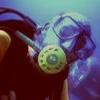This quote got me thinking. I am not new to diving with enriched air (which for the purposes of this thread I will call Nitrox) - recreational and technical/advanced. I also teach recreational divers to dive with Nitrox. I do not, however, yet fill tanks with Nitrox (haven't taken a gas blending course just yet). In all my experiences, the difference in the Nitrox % from checking it at the shop after the tank has been filled and then again on the site, the O2% reading has always decreased slightly - no more than 0.5%. Our shop uses the partial pressure mixing method (referenced to as PP fills in the quote above), where they add O2 into the tank first, then top off the tank compressed air. They have a gas blending program so they know how much psi of each to add - in case there were others out there that don't know how this is done.I am sure this could be covered in class, but if others are anything like me, when you get onsite, and are chatting with friends, it's easy to take your eye off the ball so to speak and not really pay attention. Doing the mix check pre-dive also shows that the mix may change slightly over time. Especially in PP fills where air is used to top off and the mix is not done hard, the ppO2 may creep up.
So what kind of danger could a diver be in if they planned a proper dive to the Maximum Operating Depth (MOD) of a gas, using a recreational 1.4 ATA max, knowing the % of Nitrox can change over time due to cooling and settling?
Referencing my handy Nitrox depth table showing the MODs of 1.4 and 1.6 for 26% - 40%, let's first run through an example.
A diver planning a dive to 99' at the maximum recreational 1.4 ATA limit could dive a 35% mix. That mix would have to increase 5% to a 40% for 99' to reach a 1.6 ATA. An increase of 5% is also the constant difference for a blend with a 1.4 ATA at "depth X" and a blend with a 1.6 ATA at "depth X". I am not aware of a fill settling or cooling in a manner that would cause an increase in O2 by 5%.
Again, our shop mixes using the partial pressure method, and when there is a change it's a slight decrease in the O2% after settling/cooling. So, barring there being an analyzer error (which can lead to more problems than the one we are discussing here), can a tank filled with Nitrox tank settle or cool in a manner that would lead to an increase in O2 by 5%, which could make that mix potential harmful* for that diver and their dive, if planned to the max MOD at a 1.4 ATA? *From DAN If You Dive Nitrox You Should Know About OXTOX, "The possibility of oxygen toxicity at 1.6 ata is low, but the margin of error is very slim compared to 1.4 ata."
Since I have never taken a gas blending course, I am curious to hear from those who may be able to shed some light on this issue. It would also be excellent information to add to my Nitrox course!
NOTE: I understand that technical diving needs fills to be specific and accurate to the 1/10% due to the level of increased planning down to the foot and minute. The quote above and subsequent thought is in regards to recreational diving, dive planning, and MODS for recreational mixes ONLY.




















